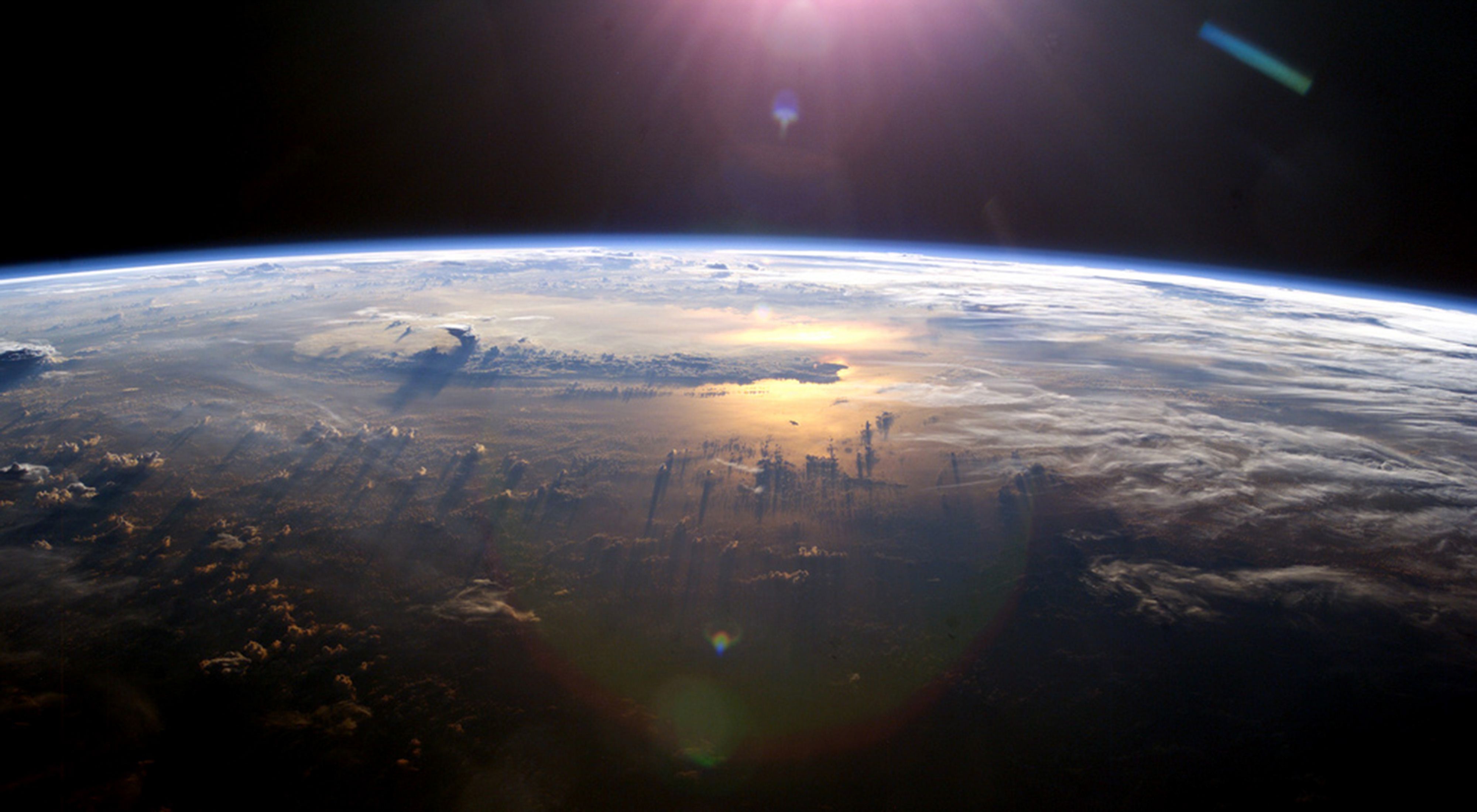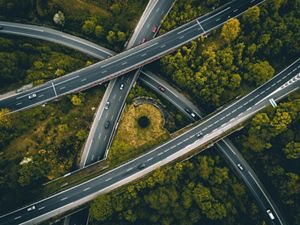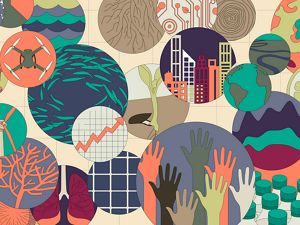The Biggest Environmental Challenges of 2017
Perspectives from our global and regional leaders on the most pressing issues facing people and the planet.
Printable PDF
DownloadTHE ENVIRONMENTAL CHALLENGES the world faces have never been greater or more complex. And never before have we lived in such an uncertain political climate.
Recent world events, such as the U.S. presidential election and Brexit, indicate that global action on climate change and other environmental issues could face stronger political headwinds in the years ahead.
But now is no time to back down. Now is the time to step up and forge ahead.
Soon more than 9 billion people will share our planet. Increasing demands for food, water, energy and infrastructure are pushing nature to its limits. And the impacts of climate change are touching down everywhere we look.
Against this backdrop, our scientists recently took a hard look at whether we really can have it all—a future where people get the food, energy and economic growth they need without sacrificing nature.
The answer is “yes”—but only if we do things right.
What emerged from our analysis was a set of key challenges facing people and nature that we must address to achieve that vision. First, we need to address climate change once and for all. Second, we need to increase food production while freezing agricultural expansion and keeping global fisheries healthy. And third, we need to focus on cities—helping them grow sustainably while maintaining healthy lands and waters.
During the year ahead we plan to sharpen our focus on these areas. At The Nature Conservancy, we believe nature-based solutions can play an important role in addressing these big challenges. The road ahead won’t be easy, but by investing in nature, we think we can find common-ground solutions that are good for biodiversity, good for the economy and good for people.
Quote: Mark Tercek
We all need to engage as citizens, get in the game, and help our leaders find the will to do the right thing.
Ensuring a low-carbon future
Making the transition to a low-carbon future and reducing the impacts of energy sprawl
Fossil fuels account for roughly 75 percent of the global emissions causing climate change. To limit global warming to less than 2 degrees Celsius, we must drive changes in energy policy that accelerate our transition to a clean energy future – while avoiding the impacts of energy sprawl. Maintaining the momentum of ambitious commitments to reduce greenhouse gas emissions, such as the Paris Agreement, will be key to accelerating the transition to clean energy solutions worldwide. And as high-emitting nations, such as the United States, China, Brazil, Indonesia and Mexico, continue innovating toward a low-carbon future, it will be important to do so in a way that creates both sustainable power generation and biodiversity conservation.
"One of the biggest areas poised for innovation is the clean energy sector."
Lynn Scarlett
Executive Vice President, Policy & Government Affairs
"In Europe there is a lot of political interest and private interest in developing renewables, but we want to make sure those renewables are being slated in the right places."
Marianne Kleiberg
Regional Managing Director, Europe
Maximizing natural climate solutions
Maximizing the role nature can play in absorbing and avoiding greenhouse gas emissions and addressing the impacts of climate change on people and nature
Nature is the sleeping giant in solving climate change. Increased investment in nature-based solutions such as avoiding forest loss, reforestation, investing in soil health and coastal ecosystem restoration gives us the best opportunity to prevent catastrophic warming and increase our resilience to climate impacts. Though clean energy technology and policy to regulate emissions are essential, they alone cannot work fast enough. Nature-based solutions are readily available, can be deployed now and could contribute more than a third of the reduction in carbon emissions needed by 2030. These solutions also provide critical value to people and nature beyond carbon mitigation—including more secure drinking water, improved food production, stronger community protection from storms and floods and refuge for some of the world’s most endangered species.
"Land use is a critical part of the climate equation."
Justin Adams
Executive Director of the Tropical Forest Alliance
(Seconded to the TFA from The Nature Conservancy)
"I think that the big opportunities that we have in North America are really for people to understand their connection to nature."
Mark Burget
Former TNC Executive VP and Regional Managing Director, North America
"Some of our best solutions will come from putting nature to work."
Lynn Scarlett
Executive Vice President, Policy & Government Affairs
Improving management of the world's fisheries
Helping create sustainable fisheries around the world
Fisheries represent a $130 billion industry that spans – and feeds – the entire world. But 57 percent of fish stocks are fully exploited and another 30 percent are over-exploited, depleted or recovering. The price tag for the world is $50 billion lost each year to overfishing and poor management. Unfortunately, most countries do not have the information or tools it will take to fix these problems. The good news is that fishermen are willing to lead the way to a more sustainable future, and there is strong consumer demand for sustainable seafood. Solutions lie in engaging directly with fishermen to pilot and replicate worldwide new practices and technologies for better understanding fish stocks and sustainable management methods, while at the same time working with world-leading fishery scientists, multinational companies and arbiters of certification labels to scale up solutions in the global seafood marketplace.
"For the ocean to be able to provide food for the more than 3 billion people who depend on it as their main source of protein, we must be more effective at managing our fisheries."
Maria Damanaki
Former Global Managing Director, Oceans
"As one of my colleague says, 'We're eating tomorrow's fish.'"
Charles Bedford
Former Regional Managing Director, Asia Pacific
"How do we integrate the elements of development with the factors that determine effective conservation?"
Luis Solórzano
Former Executive Director, Caribbean Program
Expanding sustainable agricultural practices
Helping producers increase food production while halting forest loss, balancing water for people and nature, and limiting pollutants to our rivers and seas
Humans have already cleared or converted nearly 40 percent of Earth’s ice-free surface for agriculture. Additionally, agriculture is the second largest source of greenhouse gas emissions globally – after fossil fuels. Encouraging more productive agricultural activities will be essential to meeting the growing demand for food and securing water, all while ensuring nature continues to thrive. By convening diverse partners – small-share ranchers and farmers, large agri-businesses, governments, indigenous communities and funders – we can build new business models that align conservation, food production and social agendas. Experiences in places like Brazil, Indonesia, Mexico and the United States can provide a model for connecting more producers with low-carbon practices that increase food supplies and promote economic growth while reducing agriculture’s impact on our lands and waters.
"In Northern Kenya, for example, it's about competition for grass, competition for water and competition for land to move across."
David Banks
Regional Managing Director, Africa
"The win-win for farmers is if we can invest in soil health, they can get better production off the landscape...plus we can secure more water and we can secure more carbon in that soil."
Justin Adams
Executive Director of the Tropical Forest Alliance
(Seconded to the TFA from The Nature Conservancy)
"If it's green and it grows, it requires water."
Giulio Boccaletti
Former Chief Strategy Officer
Creating a green urban future
Supporting sustainable growth of the world's cities
By 2050, two-thirds of the world’s population will live in cities. Humans have already made tremendous investments in the buildings and transportation, water and energy systems that sustain cities, but the sheer demand for the additional infrastructure necessary to support growing cities is straining both natural resources and public finances. The combination of urbanization and climate change could make cities deeply unlivable places, but it doesn’t have to be that way. Expanding investments in nature-based solutions to address urban challenges like storm water run-off and air pollution is a cost-effective way to improve the health, safety, productivity and well-being of people living in cities and to conserve biodiversity.
"Nature really can play its part in reimagining what a great sustainable city could be like."
Pascal Mittermaier
Global Managing Director, Cities
"Twenty-eight of the largest cities in Latin America are already facing seasonal challenges with water security."
Aurelio Ramos
General Manager, Latin America Region
Conservation & Systems Innovation
"About half a trillion dollars a year is spent on gray infrastructure that delivers water services directly to cities."
Giulio Boccaletti
Former Chief Strategy Officer
Global Insights
Check out our latest thinking and real-world solutions to some of the most complex challenges facing people and the planet today. Explore Our Insights




